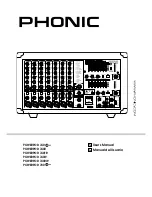
2
POWERPOD 740 PLUS / 740R / 740FR / 740W / 740RW / 780 PLUS
English
BASIC SETUP
Getting Started
1.
Turn all power off on the Powerpod mixer. To ensure this, the
ac cable should not be connected to the unit.
2.
all faders and level controls should be set at the lowest level
to ensure no sound is inadvertently sent through the outputs
when the device is switched on. all levels should be altered to
acceptable degrees after the device is turned on.
3.
Plug all necessary instruments and equipment into the device's
various inputs as required. This may include line signal devices,
as well as microphones and/or guitars, keyboards, etc.
4.
Plug any necessary equipment into the device's various outputs.
This could include speakers, monitors, signal processors, and/
or recording devices.
NB.
No devices other than speakers should be connected to the power amp
outputs. Plugging inappropriate devices into the mixer will likely cause
damage to the device. also, guitar cables should not be used to connect
amplifiers to speakers.
5.
Plug the supplied ac cable into the ac inlet on the back of the
device, ensuring local voltage level is identical to that selected
by the Voltage Selector on the rear of your device.
6.
Plug the supplied ac cable into a power outlet of a suitable
voltage.
7.
Turn the power switch on.
Channel Setup
1.
To ensure the correct audio levels of each input channel is
selected, every channel faders should first be set to 0.
2.
choose the channel that you wish to set the level of, and ensure
that channel has a signal sent to it similar to the signal that will
be sent when in common use. For example, if the channel is
using a microphone, then you should speak or sing at the same
level the performer normally would during a performance. If a
guitar is plugged into that channel, then the guitar should also
be used as it normally would be.
NB.
It is probably best to have nothing plugged into channels which are
not being set, just to ensure no signal is inadvertently sent through the
channel.
3.
This channel is now ready to be used; you can stop making the
audio signal.
4.
You should now select the next channel to set and go back to
follow steps 1 through 3.
MAKING CONNECTIONS
Channel Inputs
The Powerpod 740 and 780 models feature a total of 7 input
channels, 3 of which accept stereo signals. Each channel features
a microphone XlR jack and at least one 1/4” Phone Jack for
balanced and unbalanced connections. Each stereo channel
features different inputs jacks, accepting either microphone inputs
or stereo line inputs.
1. XLR Lo-Z Inputs
These XlR microphone inputs can be used in conjunction with
a wide range of microphones, such as professional condenser,
dynamic or ribbon microphones, with standard XlR male
connectors. With low noise preamplifiers, these inputs serve for
crystal clear sound replication.
NOTE.
When using an unbalanced microphone, please ensure phantom
power is switched off. However, when using condenser microphones the
phantom power should be activated.
2. 1/4
"
Hi-Z and Super Hi-Z Input Jacks
These inputs accept typical 1/4” TRS or TS unbalanced inputs. The
Hi-z inputs accept balanced TRS inputs, and are for Microphone
to line-level device (such as synthesizers and drum machines),
where the Super Hi-z inputs accept TS unbalanced sources, and
can be used in conjunction with devices with higher impedance
levels (including electric guitars and basses).
NB.
When using a line-level device on your mixer, the PaD -25 button should
be initiated.
3. Stereo Channel Inputs
Each of the Powerpod 740 and 780 model powered mixers provide
3 stereo input channels, the inputs of which differ slightly to the
mono channels. The 3-pin XLR inputs featured are for the addition
of microphones with typical XlR male inputs, where the 2 line
1/4" TS jacks are for the addition of various stereo line level input
devices, such as keyboards.
1
2
3
Summary of Contents for Powerpod 740 R
Page 18: ...14 POWERPOD 740 PLUS 740R 740FR 740W 740RW 780 PLUS Espa ol...
Page 40: ......







































